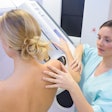
The rate of breast cancer overdiagnosis is much lower than the 30% cited by some research -- making its "harms" more myth than reality, according to an April 8 presentation at the Society of Breast Imaging (SBI) postgraduate course in Los Angeles.
"The overdiagnosis rate ranges between zero to 10%," presenter Dr. Stephen A. Feig of the University of California, Irvine told session attendees. "And it certainly doesn't negate the benefit from screening."
What is it?
What is meant by "overdiagnosis"? It's used to describe length-based sampling, Feig said: Some cancers detected at screening may not result in death because they are slow-growing, no-lethal, or, in the case of older patients, occurring in patients who may die from another, unrelated condition before they die from breast cancer.
 Dr. Stephen A. Feig.
Dr. Stephen A. Feig.To outline the controversy, Feig referred to two studies, one in Norway (New England Journal of Medicine, September 2010, Vol. 363:13, pp. 1203-1210) and one in Sweden (Cancer, February 2011, Vol. 117:4, pp. 714-722).
The Norwegian study found that breast cancer mortality was reduced by 18% in a cohort of nonscreened women and 28% in a cohort of screened women, when compared with historical controls, Feig said. Therefore, the mortality reduction from screening alone was only 10%. But this trial only followed its participants for a little more than two years, he said.
"The authors of the Norwegian screening study claimed that the 25% to 50% mortality reduction found in prior screening studies is no longer relevant," Feig said. "They suggested that most of this benefit can now be achieved through recent advances in treatment."
The Swedish study refuted the Norwegian one, finding that there was a 26% mortality reduction for women invited to screening, and a 29% mortality reduction for all women screened, according to Feig.
"Those two trials showed a 30% to 50% increased incidence of breast cancer following the introduction of screening," Feig said. "But there are multiple reasons for increased incidence of breast cancer, and overdiagnosis appears to be a minor one."
What are the real reasons for the increased incidence of breast cancer following the introduction of screening? For one, the increase a continuation of pre-existing trends, Feig said.
"The incidence of breast cancer has been increasing since the late 20th century," he said. "And these trends are accelerated by lead time. If screening confers an average lead time of two years, we'll observe 1994 cancers in 1992. Lead time similarly accelerates age effects -- we see the cancer a 52-year-old woman would get when she's 50."
A large part of the additional cancers being identified are among women who have not been previously screened. A factor that is especially seen at the minimum patient age of the screening program, Feig said.
How common is overdiagnosis?
Taking these complexities into account, other investigators such as Dr. Lázlo Tabár come to much smaller estimates of overdiagnosis -- 10% or less, Feig said, citing a study Tabár published last year in Cancer (December 2012, Vol. 118:23, pp. 5728-5732).
But not everyone agrees. Feig highlighted a paper published in the New England Journal of Medicine in November 2012 by Dr. Archie Bleyer and Dr. H. Gilbert Welch which found a 100% increase between 1976 and 2008 in the annual rate of early-stage cancers, but only an 8% decrease in the rate of late stage cancers (NEJM, November 22, 2012, Vol. 367:21, pp. 1998-2005). The researchers concluded that most early-stage cancers will not progress to advanced disease, and that in 2008, 31% of all breast cancers were overdiagnosed, according to Feig.
Although seemingly convincing, this reasoning is incorrect, Feig told session attendees. Bleyer and Welch underestimated the reduction in late-stage disease through screening by a factor of two, he said -- and their low estimate for reduction in late-stage disease through screening is less compelling than the substantial mortality reduction observed in screening trials.
"Designating all breast cancers as either 'early' -- that is, DCIS or invasive confined to the breast -- or 'late,' that is, axillary nodes or beyond, is very crude," Feig said. "It doesn't adequately reflect the 'downstaging' from screening, and doesn't take into account that the detection of smaller cancers, apart from the absence of positive nodes, improves survival."
The most reliable studies estimate that breast cancers are overdiagnosed between zero and 10% of the time, not 30%, according to Feig. But even a 30% estimate doesn't cancel out a substantial mortality reduction in screening trials, he said.
"Positive results from randomized, controlled trials are not negated by length-based sampling, lead time bias, or selection bias," he told attendees. "Most DCIS is not overdiagnosis."
The real danger from "overdiagnosis" is that women may be dissuaded from being screened and insurers will stop or reduce their screening reimbursement, according to Feig. And if that happens, the myth of overdiagnosis will affect the reality of clinical practice.
"The current confusion, misunderstanding, and controversy could have been prevented by simply reading and understanding the screening mammography literature and placing the health and well-being of our patients first," Feig said.



















